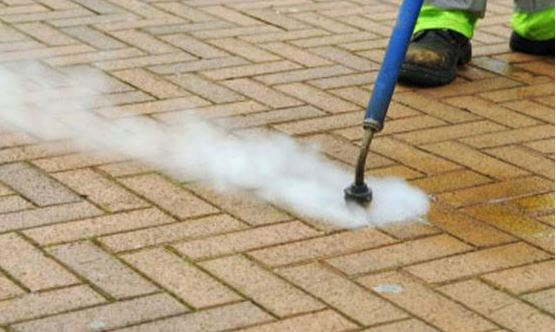
Hot water steam cleaning description:
Hot Water / Steam Cleaning is the number one choice for degreasing and removing oil, sterilizing, disinfecting, dissolving resins, gum removal, flushing away chemicals and poisons, and. Hot water pressure washing is used in shops and other facilities where encrusted dirt, grime, and other dried on substances accumulate. Conversely, cold water pressure washing is great for vehicles, facilities, and ground maintenance areas such as sidewalks and architectural embellishments. Hospitals also use steam to sanitize and sterilize sensitive areas. Sanitization simply means applying high heat to a surface to kill microorganisms.
Think of it like washing greasy dishes in the sink. No matter how much soap you use, you are only smearing the grease around in cold water. Add hot water, and it cuts through the grease and oil in no time. The same applies to cleaning with a pressure washer. If oil or grease is present in any form, you will need a hot water pressure washer to remove it quickly.
The Science Behind How Hot Water / Steam Cleaning Works
Hot water packs a powerful energetic punch when released into the cleaning equation. This energy also causes a reduction in the water’s surface tension allowing it to easily and more effectively penetrate the molecules of grease and grime.
There are three key elements to a hot water pressure washer — heat, agitation and soap — that successfully remove grease and grime. Here’s how they work:
Heat, as described above, creates a high-speed molecular action that causes the cleaning agent to be more active and reduces water’s surface tension so it can effectively penetrate grime at the molecular level.
Agitation is the impact that comes from the water volume and water pressure hitting the surface— similar to the action of hand scrubbing the dinner plate in your kitchen sink.
Soap (often referred to by pressure washer users as “detergent”) chemically breaks the bond between dirt and the surface. It starts when the molecules of oil and grease attach themselves to dirt and keep them trapped or bound to the surface. Detergents use softening agents, technically referred to as “surfactants” (an abbreviation for “surface active reagents”) to emulsify the oil and grease—this is the process in which two or more immiscible liquids, like oil and water, no longer repel each other but actually mix. Once the oil and water are able to mix forming an emulsion, the dirt—still clinging to the oil and grease—is carried away in the wash water.
Hot water / Steam cleaning brings together a perfect balance of all three of these key elements—heat, agitation and soap—to deliver a pressure cleaning knockout punch.
It’s simple: whatever cold water cleans, hot water / steam cleaning will clean it better and faster.

